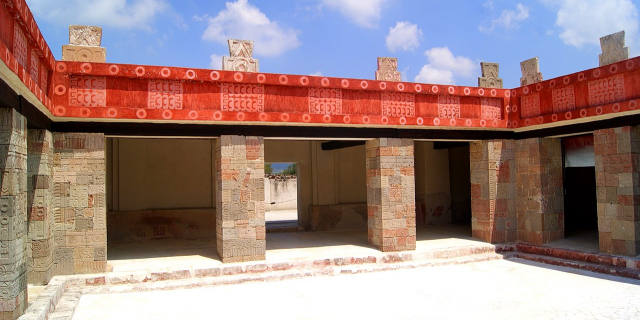The Chapel of the Virgen del Rosario is the chapel attached to the Church of Santo Domingo in the city of Puebla, Puebla, Mexico. A work of the 17th century, the summit of the New Spanish Baroque, it was described in its time as the Eighth Wonder of the World by Friar Diego de Gorozpe in a print from 1690, and regarded as such for a long time in New Spain, as well as La Casa de Oro (The Golden House) and Domus Aurea. It is one of the most prominent examples of the New Spanish Baroque and one of the greatest artistic-religious achievements in Mexico. It is a chapel full of symbolism, with each element representing something related to the beliefs of Catholicism and the Dominican Order. It is located on pedestrian avenue 5 de Mayo number 407.
The building is part of the Historic Center of Puebla City, which was added to the UNESCO World Heritage List in 1987.
 Plan of the chapel.
Plan of the chapel. Decoration details at the Chapel of the Rosario
Decoration details at the Chapel of the RosarioThe order of the Our Lady of the Rosary was promoted by the Dominican Order, who dedicated in each of their convents a chapel to their devotion. In Mexico it was no exception when the first religious of the order arrived in 1526, but it was not until 1531 when they began the construction of their first important church in Puebla, which is also dedicated to the Archangel Michael however the Chapel of the Rosario was conceived until 1650 and completed and consecrated on 16 April 1690.[1]
It was the first in Mexico dedicated to the Our Lady of the Rosary.[2] Its construction served a double purpose: to worship the Virgin and teach the faithful the prayer of the Holy Rosary. It was conceived by the Dominican Friar Juan de Cuenca, who in 1650 began its construction,[3] but given the magnitude of the work, until 1690 it was completed by two other Dominicans Friar Agustín Hernández and Friar Diego de Gorozpe, who they dedicated the distinguished bishop of the Puebla of the Council of His Majesty Manuel Fernández de Santa Cruz,[4] and celebrating its consecration on April 16, 1690, to coincide with the date on which the City of Puebla de los Ángeles was founded. The celebration lasted 8 days (La Octava),[5] pronouncing in each of them a sermon, processions, masses and events turning it into a great stage of joy.[3]
The determined impulse to the teaching of the Holy Rosary and the favorite devotion to the Virgin of Our Lady of the Rosary, which was given to them in the 17th century, explains the complexity of the great work, which as soon as it was finished and qualified as the Eighth Wonder of the World.
In 1971 a team of restaurateurs sponsored by the Mary Street Jenkins Foundation did a restoration work in the Chapel.





























Add new comment